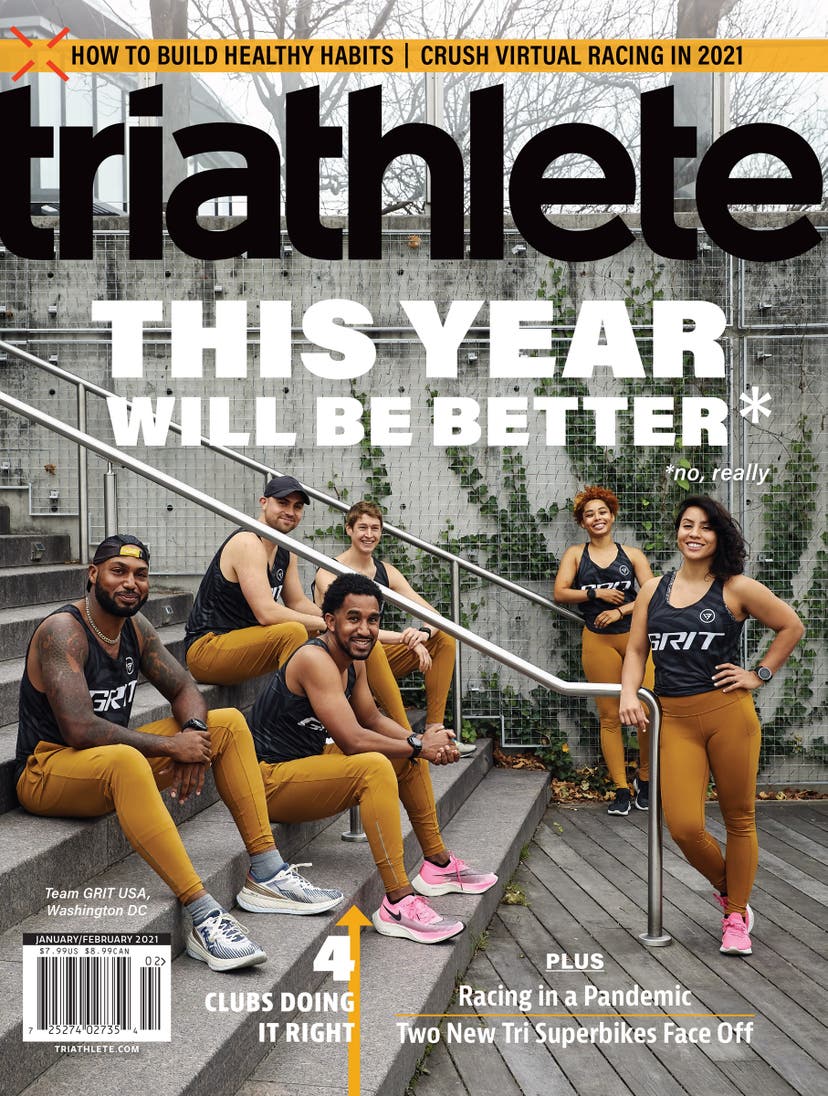More Than Ever, Triathlon Clubs Matter
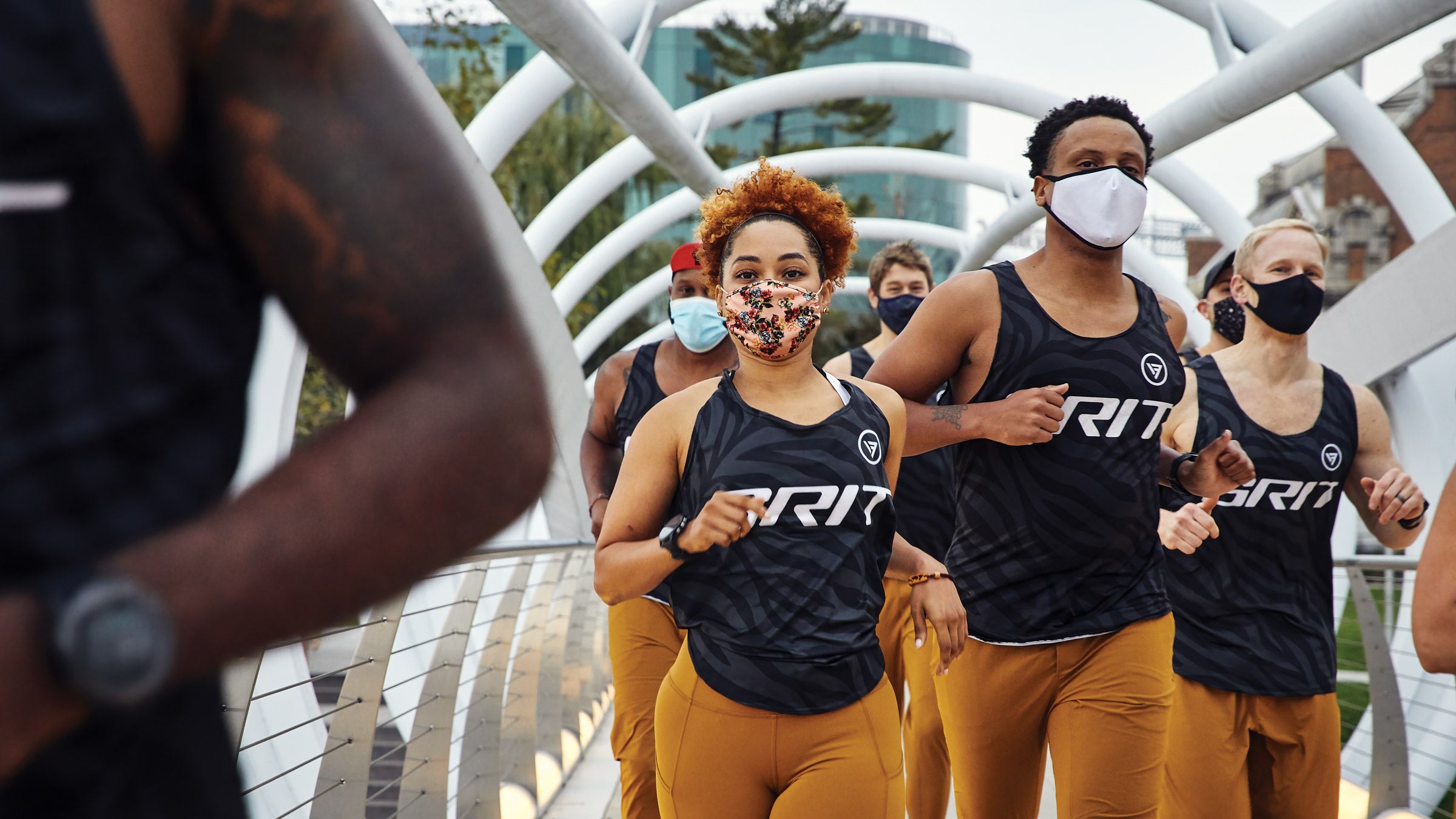
The Grit USA Triathlon Club gets a workout in. (Photo: Eli Meir Kaplan)
Triathlon may be an individual sport, but it’s certainly not a solitary one. Clubs and teams are the beating heart of triathlon, forming a community of friendships forged in freezing open-water swims and sweltering trail runs. When COVID-19 restrictions put a halt to Masters workouts and adventures with training buddies, what did that mean for triathlon clubs? What would happen when clubs couldn’t gather for group rides and post-race pancake breakfasts?
The answer: They adapted, because that’s what triathletes do. When they couldn’t have a group ride, they took their watts and smack talk to Zwift. When large, in-person gatherings were banned, meetings and seminars seamlessly migrated to Zoom. When races were canceled, clubs and teams turned their time and energy to something bigger than sport. In a time when it would be easy to hit the pause button and resume activities when—as we keep saying with a broad, vague gesture—“all of this is over,” many clubs instead ramped up their efforts to serve their members when they needed it most and to bring in new ones. The heart of triathlon hasn’t stopped. In fact, it’s beating stronger than ever.
3P Tri Team
Los Angeles, CA | 3ptriteam.com
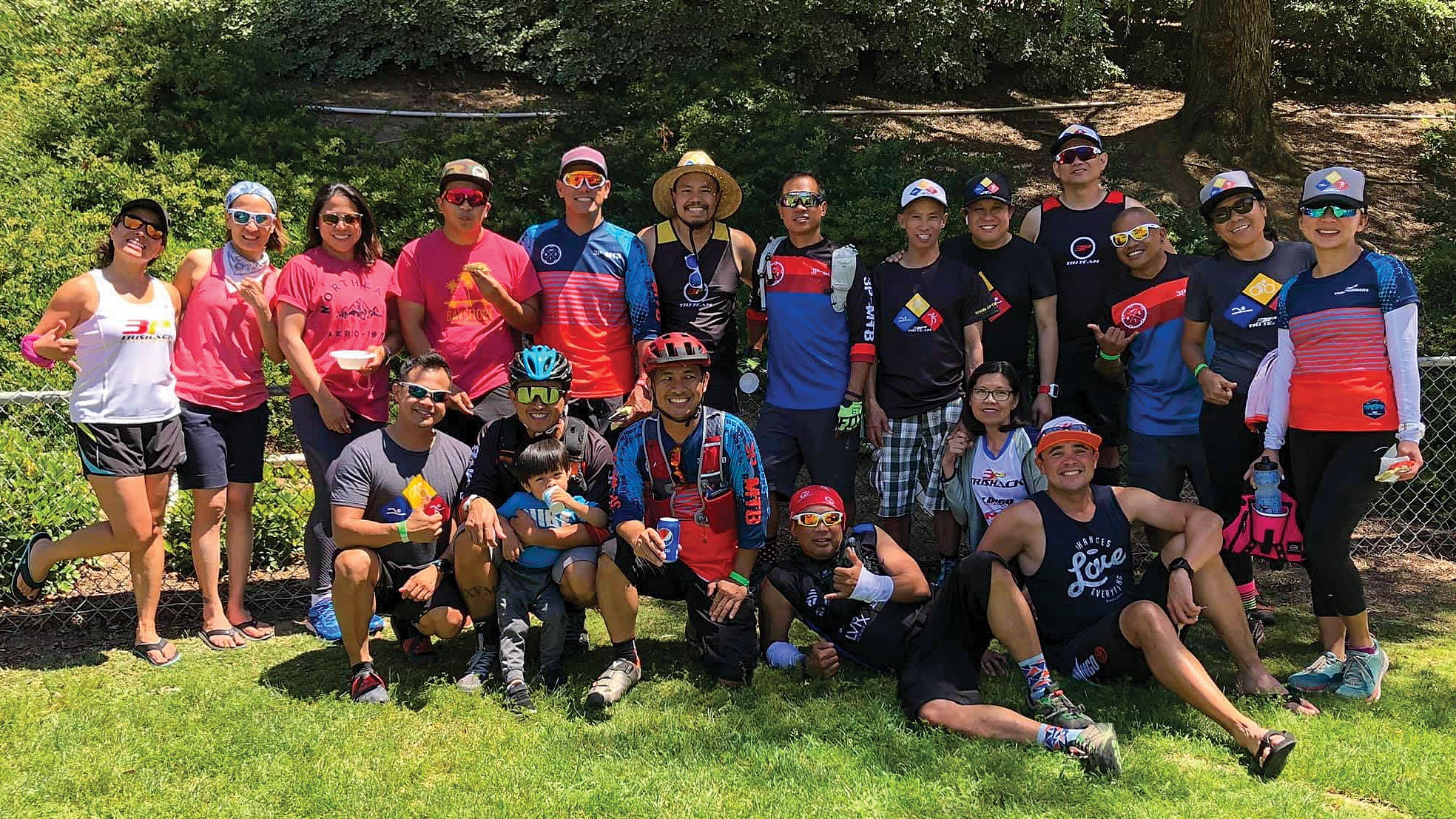
When Kristoffer Crisostomo, Brian Masayon, and David Bahia started their new tri club in 2017, they didn’t take themselves too seriously. After all, the P in 3P stood for “pogi,” Filipino for “handsome men.” But the three handsome men soon became an all-out tri team, attracting more than 150 members in its first year. Four years later, the club has grown to more than 400 members in four countries, with much of that growth coming in the past year.
“Now the 3P has a different meaning, because it’s not about the three of us anymore, but this family of triathletes,” Masayon said. “3P is the three phases of triathlon: swim, bike, and run. It’s also perseverance, persistence, and personal best.”
The club takes itself a little more seriously now, especially when it comes to taking care of their members. “The moment they locked down everything, we wanted to create a place where people could find some normalcy,” Masayon said. “Almost immediately, we started doing virtual rides on Zwift every day, so we could stay connected. What ended up happening is that racing virtually allowed our members to get closer to one another and develop an even deeper sense of family, comfort, and support. When people were losing their jobs left and right, our rides became a place where they could get what they needed, whether it was distraction or someone to talk to.”
And sometimes, people needed to race. When COVID caused a complete clear-out of racing calendars in California, many 3P members felt unmoored. Though the club is known for its laidback, fun nature, it’s still made up of triathletes, who by definition thrive when striving for a goal. Crisostomo, Masayon, and Bahia worked with club members, area businesses, and the local government to develop a free half- and full-Iron distance triathlon that followed all COVID safety protocols. More than 60 members participated, some covering their chosen race distance for the first time ever. In a year when victories were hard to come by, 3P found a way to give everyone a win.
“It wasn’t a competition,” Masayon said. “We didn’t even time our athletes. We just said, ‘No matter what, if you come and do it, we will support you from start to finish.’ We’re all brothers and sisters, and we back each other up no matter what. It’s been a tough year. We’re blessed to have each other to get through it.”
Focus on your members. Identify their needs. Your intention to help others will greatly determine the success of the club. When your members see the sincerity and purpose of why you’re doing this, they will love you and support you. – Brian Masayon, co-founder 3P Tri Team
Austin Triathlon Club
Austin, TX | austintriclub.org
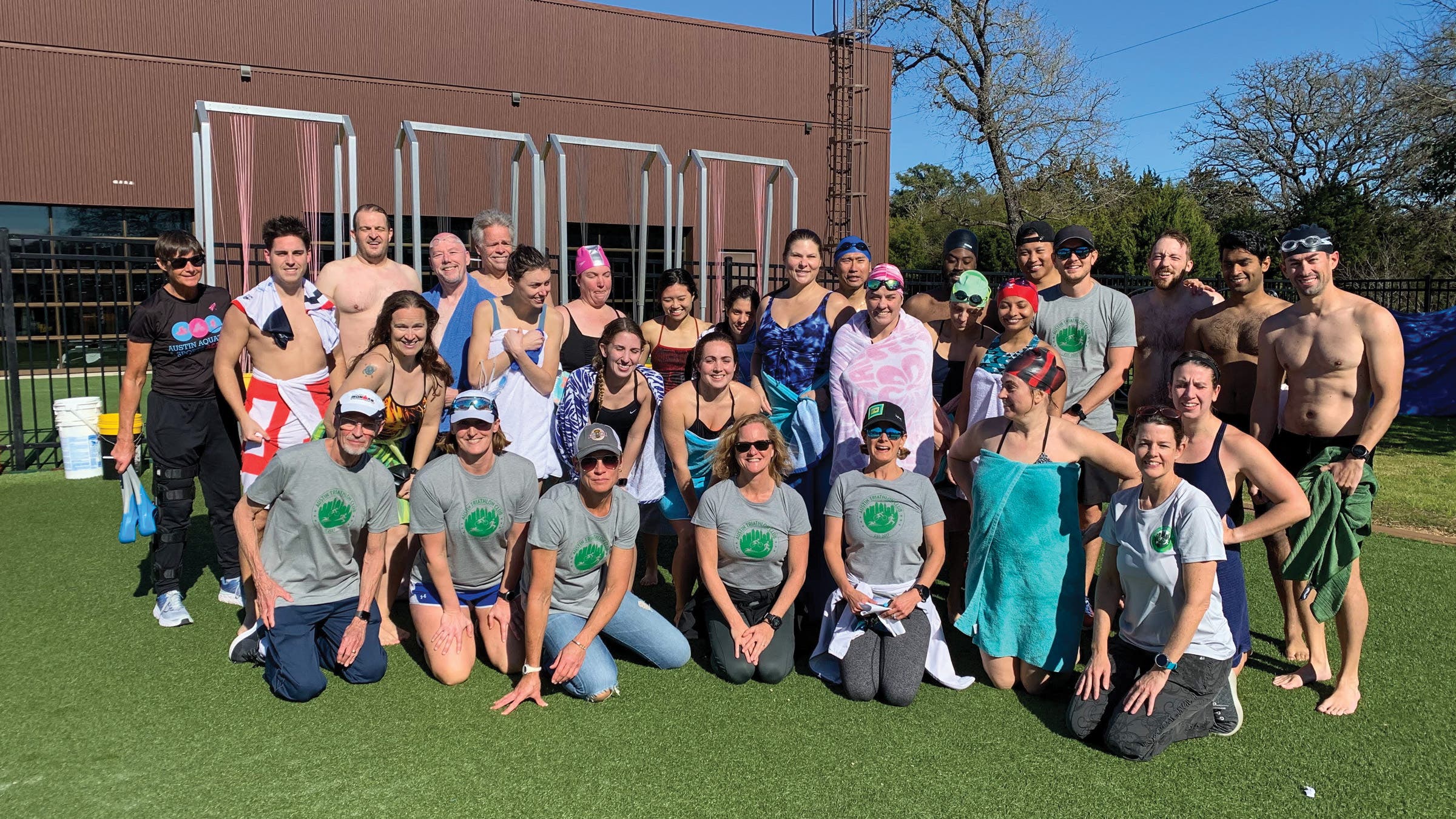
The Austin Triathlon Club kicked off 2020 with a bang, with more than 50 new triathletes joining the club’s learn-to-tri program at the start of the year. More than 350 members were participating in weekly workouts and clinics as they geared up for what they thought would be a robust season of racing.
“And then…COVID hit,” board member Carrie Barrett sighed. “Immediately, we had to pivot.”
Though the Austin Tri Club wasn’t the first to utilize technology to stay connected during the pandemic, it was one of the first to think beyond the Zwift ride. “We rallied to provide events that created community and engagement instead of focusing on miles and speed,” president Andrea Fisher said. “We needed to come up with a plan to be creative and engaging.”
To start, they built out an “Adapting in Adversity” virtual education series, which showcased livestreamed interviews with industry experts. Some interviews were inspirational, others educational—but all centered around the challenges of the rapidly-changing pandemic, providing a timely way for athletes to learn about and share coping skills for the new normal.
The team also found ways to share collective experiences in socially-distant ways. Events like the Austin Tri Club Treasure Hunt allowed members to swim-bike-run their way through the city, chasing after clues and using social media and apps to track their movements and share their discoveries with club members. “It initiated new friendships and a friendly, fun-spirited network for those who may have otherwise felt isolated,” Barrett said. “So many wonderful Austin businesses donated prizes and gift cards for participants, even though many of these businesses, too, were and are feeling the impact of COVID.”
In a year where many triathlon clubs saw a decline in engagement and growth, the Austin Tri Club saw a steady stream of new members, all of whom received a hearty welcome (virtually, of course) from veterans. When in-person training and racing events resume, Fisher is confident virtual connections will seamlessly roll into real-life friendships. “We created a place where we were able to still connect and make friends with new members virtually. We are a common ground where athletes can come together and grow friendships as they either start or continue their journey with triathlon.”
When it comes to virtual events, think outside the box and keep it completely welcoming and inclusive. Don’t set standards that will only reward the faster athletes, or those who are willing to log hundreds of miles. By doing that you are discouraging those who are new to the sport or possibly those who have disabilities. Create the event and engagements in a way that enables members to share stories, share experiences, encourage others, and provide a support family for all who take part. Ultimately, that is what we are all looking for, a family to join and feel part of. – Andrea Fisher, Austin Triathlon Club president
GRIT USA
Washington, DC | gritusa.club
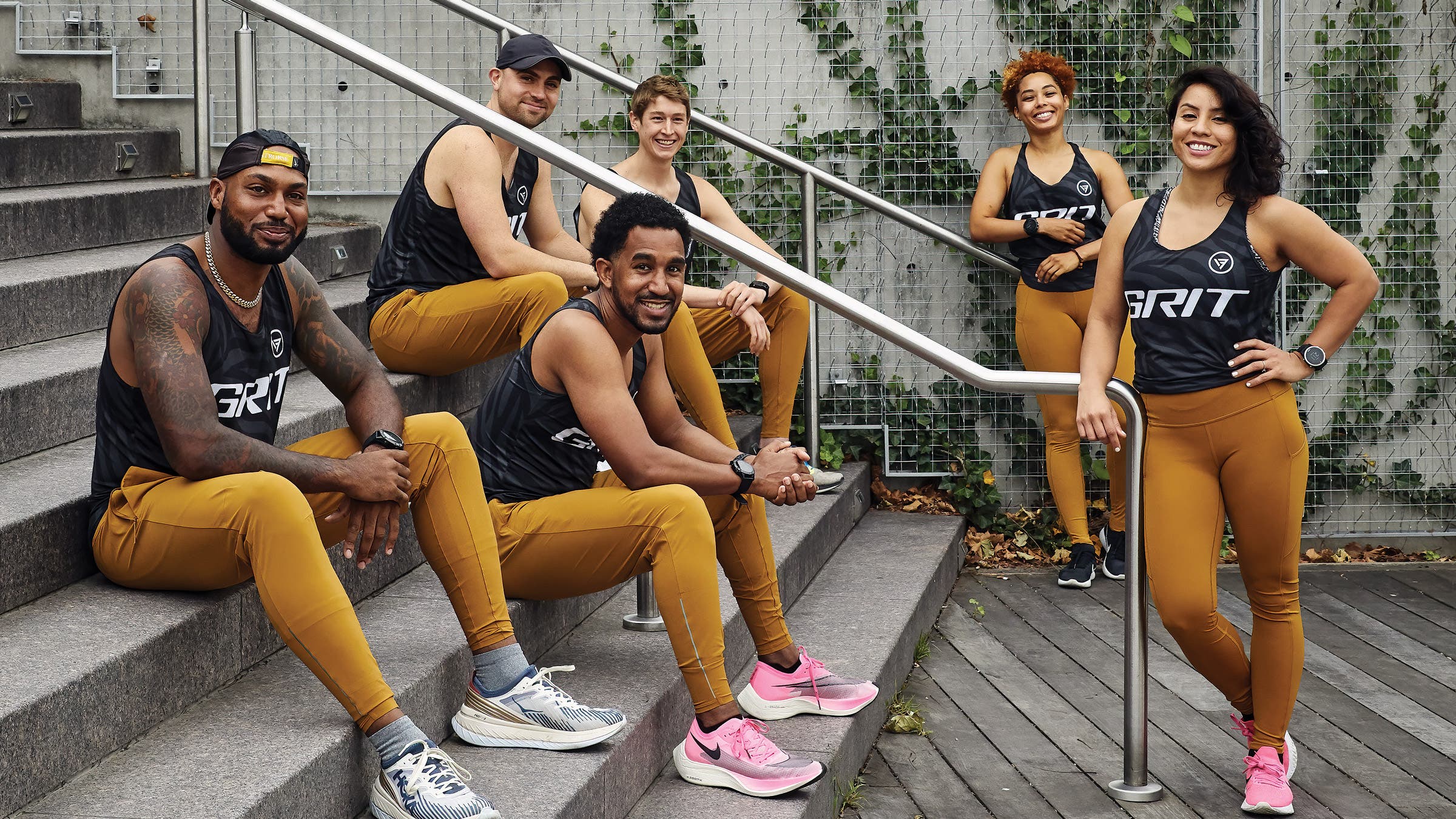
The timing of GRIT USA’s launch couldn’t have been worse—the elite endurance team was only three months old when the COVID pandemic hit the U.S., stalling the busy racing calendar they had painstakingly laid out. But, in a way, the timing of their launch also couldn’t have been better—in the midst of social unrest and a call for racial justice, GRIT USA was more than ready to carry out its mission.
“The inner character of the group always had a focus on cultural and social responsibility at the forefront of its creation. We are an endurance group composed of citizens who love our city,” member Colin Ball said. That love is expressed through what GRIT calls “athletic activism”—using sport as a platform for individual, community, and cultural improvement.
With racism and inequity dominating the news cycles, GRIT USA members pooled their time and talents to raise money for nonprofit organizations that focus on health disparities, systemic injustice, and underserved communities worldwide. They accomplished this through the Speed Project DIY, a virtual decentralized version of the famed race from Santa Monica to Las Vegas. After mapping out a 60-mile route circling Washington, DC, members ran, relay-style, for 31 hours and 15 minutes (the current record for the desert Speed Project course), collecting pledges per kilometer run. In all, the effort raised $85,385.
The team also collaborated with organizers of Run The Polls, a group of activists working to increase voter participation throughout the U.S. GRIT USA members led multiple community walks and runs in the weeks and months leading up to the November election, each time talking with participants about voter registration, mail-in ballots, early voting, and staffing the polls.
“Although the COVID pandemic and political tensions have divided our country, GRIT has shown a strong sense of community and perseverance in such adversity, which has become an inspiration,” member Leslie Prado said. “In continuing to evolve and train, GRIT demonstrated commitment to expanding the definition of an athlete.”
Together we have achieved goals that tested our speed, work ethic, mental fortitude, organizational skills, endurance, and many other areas within our athletic and personal lives. Collectively, we do not believe we have yet reached our full potential. This journey has allowed us to not only compete against others, but ultimately compete against ourselves, constantly redefining our limitations. I believe it’s the attitude that has gotten us this far. We bet on ourselves, even if we fail, we can be proud we tried. – Marcus Fitts, GRIT USA founder
TriLatino Triathlon Club
New York, NY | trilatino.org
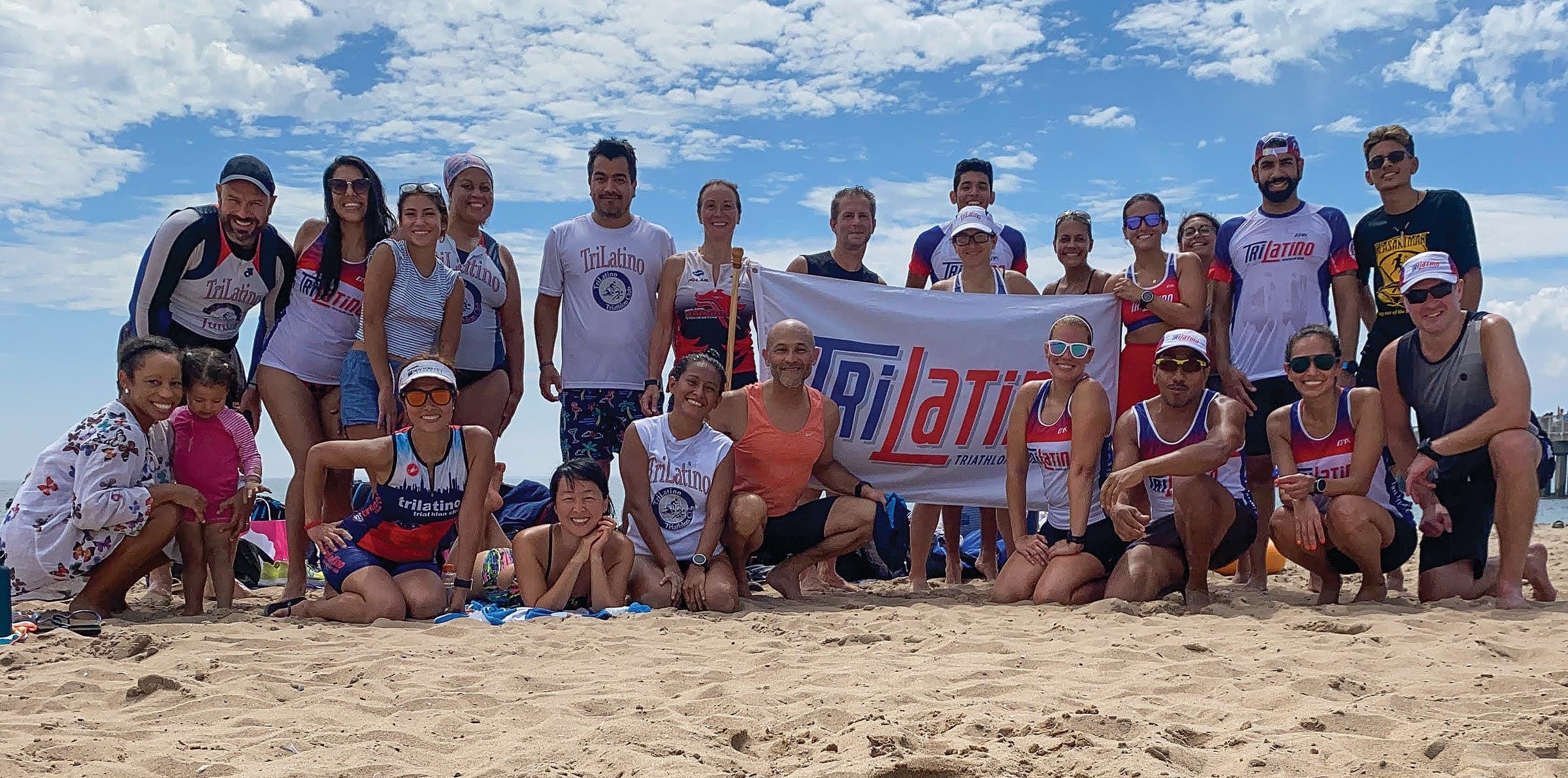
Ten years ago, six Latino triathletes noticed the lack of people of color in endurance sports and sought to make a change. To accomplish this, they knew they couldn’t just create a club—they had to build a community. They’ve done that. By serving as role models and gaining the trust and admiration of their community, TriLatino has grown from six athletes with a dream to a global network of more than 300 members.
When COVID hit, it hit the Latino population especially hard. One study of more than 7,000 Latino-owned businesses found that they had fewer resources to weather the ongoing storm. When requesting emergency funding from the Payroll Protection Program, Latino-owned businesses received approval at only half the rate of white-owned businesses; of those that got approved, only 3% of Latino-owned businesses got the full amount of funding requested. That impact trickled out into the rest of the Latino community as well.
TriLatino saw the effects firsthand: “The club’s youth program for local high school students collapsed under the weight of school closures and family struggles. Members and their families were contracting the virus and their households were financially impacted,” member Lisa Kay Davis said. “COVID wasn’t a pause for us, but a hard stop.”
Like many nonprofits serving communities of color, TriLatino faced imminent risk of shuttering and losing their decade-long legacy. The organization was used to overcoming obstacles, but the unprecedented challenges of the global pandemic left them reeling. Instead of throwing in the towel, though, the organization looked at how they could make the most of their bare-bones budget and skeleton staff. Their community was hurting and they wanted to help, even if they were limited in what they could offer.
“We had to make a conscious choice to embrace this new norm and tackle its challenges head-on,” Davis said. “One thing we noticed was that morale had sunk to really low levels. The leadership realized a need to focus on the mental and emotional components of health and wellness.”
They started by checking in: first with members of the triathlon club, then with the community at large. TriLatino created a safe place for people to share what was happening, what they needed, and what resources they had to offer. Remote workouts allowed members to combat stress and isolation while sheltering-in-place or working from home.
A COVID relief grant from USA Triathlon, awarded in late 2020, provided some much-needed funding to help the organization move to hybrid programming, which provided affordable training options for adults who had been financially impacted by the pandemic. “It was really important for us to help people maintain their fitness and health during these abnormal times,” Davis said. “We’re not just a triathlon club. We’re a safe place for our membership and the greater community. We wanted to provide resources for people to maintain their mental health, physical fitness, and social relationships, regardless of restrictions or hardships.”
In a sport where participation is disproportionately represented by individuals having an income more than twice the national average, our goal is to make triathlon more accessible to individuals of lower income. COVID made us go beyond our community ties and challenge the endurance industry to recognize the disparities in the financial impact. – Lisa Kay Davis, TriLatino board member
Honorable Mentions
Dare2Tri
Nationwide | dare2tri.org
When tri clubs pivoted to online workouts, accessibility wasn’t always at the forefront. Dare2Tri stepped in to fill that gap, creating accessible weekly virtual bike and strength workouts for paratriathletes around the country.
California Triathlon Club
Nationwide | californiatriathlon.org
This 4,500-strong triathlon club grew exponentially during the COVID pandemic, thanks to a zero-dollar membership and an all-comers attitude. An expanded variety of socially-distanced grassroots races throughout the year helped athletes get their racing fix without having to put their health or households at risk.
The Seals
Chicago, IL
A team of veteran triathletes and new swimmers alike formed out of necessity when Chicago closed gyms, parks, community centers, and other facilities to stem the spread of COVID. Each week from April to September, The Seals stormed Chicago’s 57th Street Beach for an open-water swim in Lake Michigan.
Project Podium
Tempe, AZ | teamusa.org
Project Podium, a USA Triathlon program to train top young male triathletes to achieve medal performances in international competition (and ultimately the Olympics), took advantage of race cancellations to create their own COVID-free bubble in Park City, Utah. By living and training together, members of this elite squad have found a way to support each other through the unique challenge of an Olympic pursuit in the midst of a global pandemic.

How To…
Find a Club
Want to check out a club without any pressure to join? Many offer free training events or races for the community at large, which will let you get a feel for the club before committing. “We have several organized and fully sagged events that are free and full of all of the bells and whistles, like stocked aid stations, drone photography, and a finish line festival,” Masayon said. “It’s a great way to meet our members and see what we’re about.”
Grow Your Club
Triathlon clubs don’t follow the adage of “if you build it, they will come.” Instead, the most successful clubs are the ones that consistently go out and meet members where they’re at, providing programs that are exciting, appealing, and engaging. People have to want to join your club. “It is up to us—the multisport leaders, coaches, and ambassadors—to keep the tri-fires burning,” Barrett said.
Make Your Club Amazing
A distinct identity makes it clear what your club is about and who you are trying to attract. “We are looking to create a circle of individuals dedicated to a lifestyle of competition and fun, who can look beyond stats, medals, and clout chasing,” Fitts said. “We’re here for racing because we enjoy it.”
What’s the Club Culture in Your Region?
New York-style thin crust versus Chicago deep-dish—they’re both pizza, but they’re not really the same. So, too, do triathlon clubs differ from region to region, with a distinct culture within their shared love for swim-bike-run.
| Region | The Culture |
| Southeast | The clubs down south are small but mighty—and loud. If you thought SEC football rivalries were intense, wait until you hear the smack talk between triathlon clubs at races in Florida, Georgia, Texas, and Kentucky.
Notable Clubs: Sarasota Sharks Tri Club – Sarasota, FL University of Alabama Club Triathlon – Tuscaloosa, AL Peachtree Tri Club – Atlanta, GA Friends Who Tri – Fort Worth, TX |
| Midwest | Family is at the forefront for clubs in Wisconsin, Minnesota, Michigan, and Ohio. You’re just as likely to get an invitation for a Saturday morning group ride as you are for a Saturday evening cookout. If you need someone to watch your kids while you travel for a race, tri clubs offer a dozen built-in aunts and uncles, ready to spoil them rotten. Notable Clubs: Fox Cities Triathlon Club – Appleton, WI Real Women Tri – Grandville, MI TriRochester – Rochester, MN |
| West | Tri teams and clubs are massive in California, Colorado, and Arizona, but don’t let that intimidate you—bigger groups mean more opportunities. When 100 members turn out for a ride, it’s easier to break up into smaller groups by pace, ensuring no one is dropped.
Notable Clubs: ONE Multisport – Scottsdale, AZ Endurance Nation – Monrovia, CA Golden Gate Triathlon Club – San Francisco, CA Boulder Triathlon Club – Boulder, CO |
| Northeast | In a metropolis like New York City, Boston, or Washington, DC, it’s all about working hard and playing hard. The two philosophies overlap in corporate tri clubs, where employees meet up for post-work group rides or lunchtime yoga classes at the company gym.
Notable Clubs: New York Police Department Triathlon Club – New York City, NY General Electric Triathlon Team – Boston, MA WarnerMedia Triathlon Club – New York City, NY |
